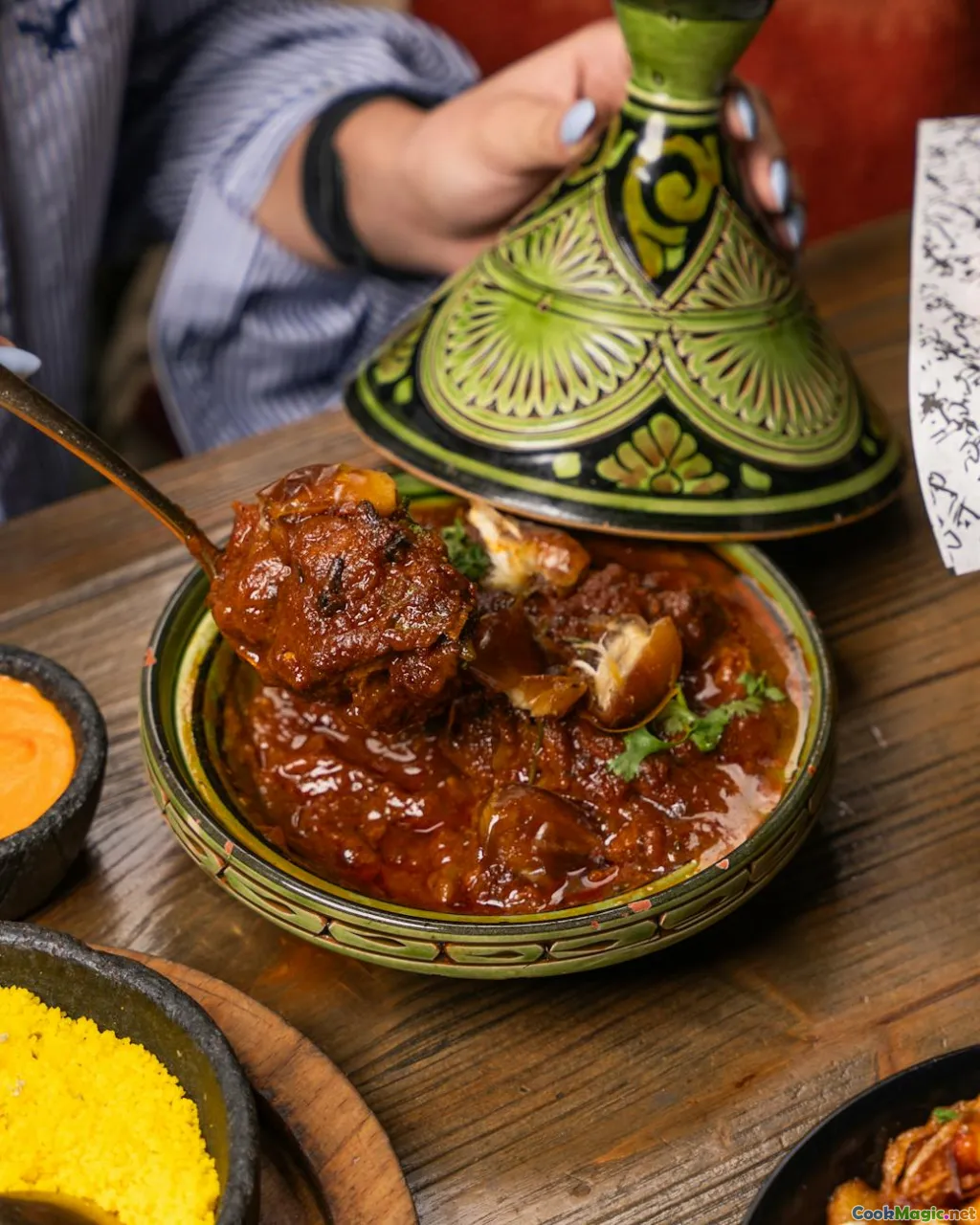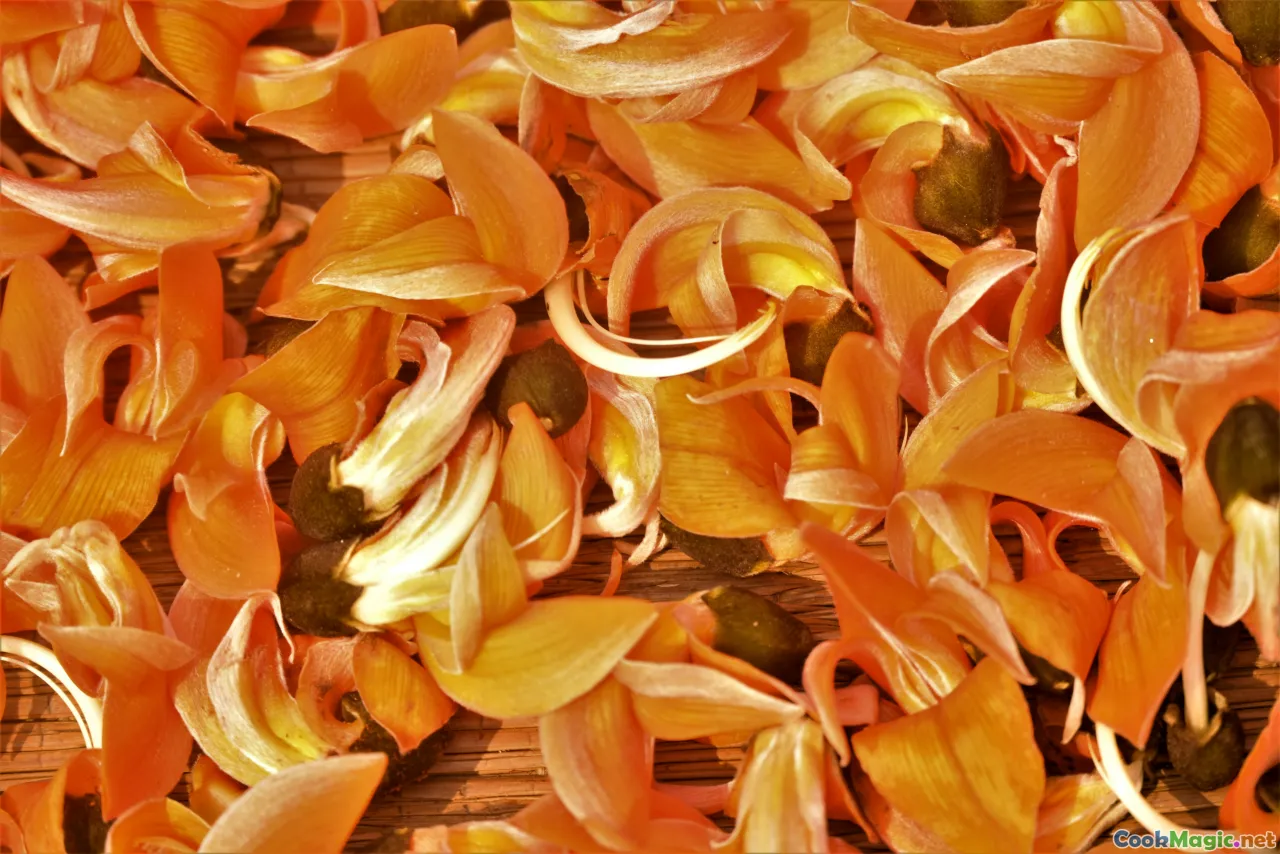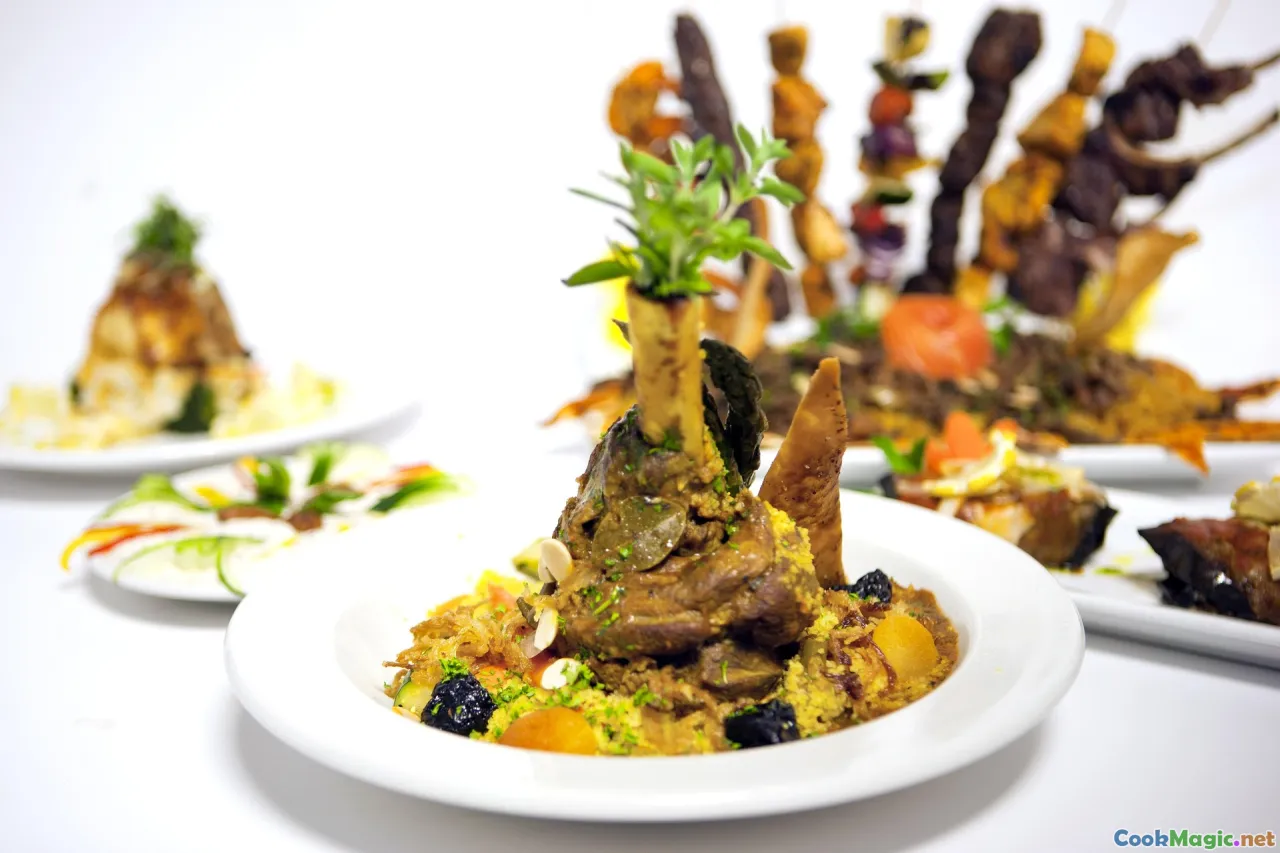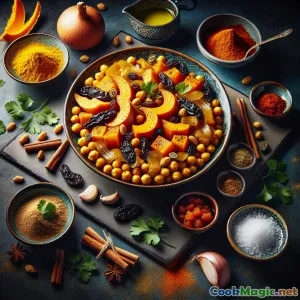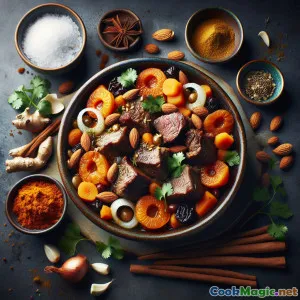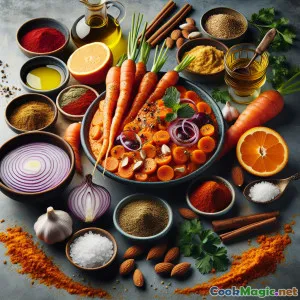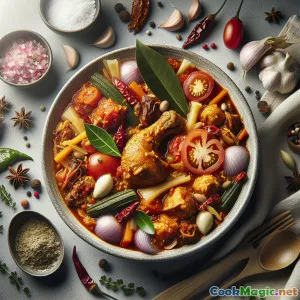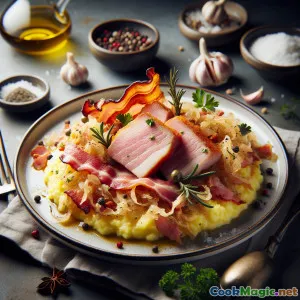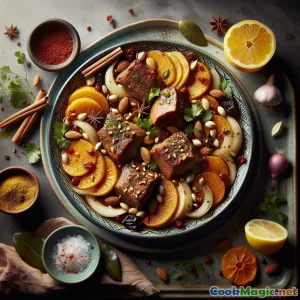
摩洛哥风味榅桲小牛塔吉锅配藏红花
(Moorish Quince & Veal Tajine with Saffron)
(0 评论)食材
-
900 grams 小牛肩肉,去脂去筋,切成均匀方块
(Cut into 3 cm cubes for even cooking)
-
3 pieces 榅桲、去核,切成楔形
(Ripe but firm; 8 wedges per fruit)
-
2 large 黄洋葱,切成薄片
(Sweet onions preferred)
-
4 cloves 大蒜(剁碎)
(Freshly minced for best aroma)
-
3 tbsp 橄榄油
(For searing and sautéing)
-
1 pinch 藏红花丝
(Bloom in warm stock for maximum color and aroma)
-
1.5 tsp 姜粉
(Classic warm Moroccan backbone)
-
1 tsp 肉桂粉
(Balances quince sweetness)
-
1 tsp 姜黄
(Adds gentle earthiness and color)
-
1 tsp Ras el hanout
(House spice blend; optional but recommended)
-
1 piece 肉桂棒
(For perfuming the braise)
-
0.5 tsp 现磨黑胡椒
(根据口味调整)
-
1.5 tsp 海盐
(Season in layers)
-
2 tbsp 蜂蜜
(For glazing quince)
-
2 tbsp 柠檬汁
(Freshly squeezed; prevents quince browning)
-
1 tsp 橙花水
(Floral top note; use sparingly)
-
500 ml 小牛骨汤或低钠鸡汤
(Warm before adding)
-
80 grams 对半切干杏
(Adds jammy sweetness)
-
60 grams 焯水去皮的杏仁,烤香
(Crumble or leave whole for crunch)
-
2 tbsp 新鲜香菜(切碎)
(用于装饰)
-
2 tbsp 新鲜切碎的欧芹
(Bright herbal finish)
-
1 tbsp 烤香芝麻籽
(Final garnish for texture)
-
1 piece 月桂叶
(Subtle aromatic depth)
(Cut into 3 cm cubes for even cooking)
(Ripe but firm; 8 wedges per fruit)
(Sweet onions preferred)
(Freshly minced for best aroma)
(For searing and sautéing)
(Bloom in warm stock for maximum color and aroma)
(Classic warm Moroccan backbone)
(Balances quince sweetness)
(Adds gentle earthiness and color)
(House spice blend; optional but recommended)
(For perfuming the braise)
(根据口味调整)
(Season in layers)
(For glazing quince)
(Freshly squeezed; prevents quince browning)
(Floral top note; use sparingly)
(Warm before adding)
(Adds jammy sweetness)
(Crumble or leave whole for crunch)
(用于装饰)
(Bright herbal finish)
(Final garnish for texture)
(Subtle aromatic depth)
营养
- 份量: 4
- 每份大小: 1 碗 (350g)
- Calories: 720 kcal
- Carbohydrates: 0 g
- Protein: 45 g
- Fat: 34 g
- Fiber: 6 g
- Sugar: 22 g
- Sodium: 820 mg
- Cholesterol: 165 mg
- Calcium: 90 mg
- Iron: 4.8 mg
制作步骤
-
1 - Bloom saffron and prep:
Warm the stock until steaming, add saffron to bloom. Core and wedge the quince, toss with lemon juice to prevent browning. Slice onions and mince garlic.
-
2 - Season and brown veal:
Pat veal dry. Season with salt and pepper. Heat olive oil in a tajine base or heavy Dutch oven over medium-high. Sear veal in batches until well browned.
-
3 - Sweat the Aromatics:
Reduce heat to medium. Add onions and a pinch of salt; cook until translucent and sweet. Stir in garlic and cook until fragrant, about 1 minute.
-
4 - Bloom spices and deglaze:
Stir in ground ginger, cinnamon, turmeric, and ras el hanout. Toast 30 seconds. Add a splash of saffron stock to deglaze, scraping up browned bits.
-
5 - Braise the veal:
Return veal and any juices, add remaining saffron stock, cinnamon stick, and bay leaf. Bring to a gentle simmer, cover, and cook until veal is tender.
-
6 - Prepare quince glaze:
In a skillet, combine honey with a spoon of braising liquid. Warm gently until glossy and fluid.
-
7 - Caramelize the quince:
Add quince wedges to the skillet and cook over medium heat, turning, until lightly caramelized and just tender but still holding shape.
-
8 - Finish tajine with fruit:
Stir dried apricots into the braise. Nestle caramelized quince on top. Simmer uncovered to thicken the sauce to a glossy coating consistency.
-
9 - Garnish elements:
Toast almonds lightly if not already done. Adjust seasoning with salt, pepper, and a few drops of orange blossom water if using.
-
10 - Rest and Serve:
Let the tajine rest off heat 5 minutes. Scatter cilantro, parsley, and sesame seeds. Serve with warm flatbread or plain couscous.
Warm the stock until steaming, add saffron to bloom. Core and wedge the quince, toss with lemon juice to prevent browning. Slice onions and mince garlic.
Pat veal dry. Season with salt and pepper. Heat olive oil in a tajine base or heavy Dutch oven over medium-high. Sear veal in batches until well browned.
Reduce heat to medium. Add onions and a pinch of salt; cook until translucent and sweet. Stir in garlic and cook until fragrant, about 1 minute.
Stir in ground ginger, cinnamon, turmeric, and ras el hanout. Toast 30 seconds. Add a splash of saffron stock to deglaze, scraping up browned bits.
Return veal and any juices, add remaining saffron stock, cinnamon stick, and bay leaf. Bring to a gentle simmer, cover, and cook until veal is tender.
In a skillet, combine honey with a spoon of braising liquid. Warm gently until glossy and fluid.
Add quince wedges to the skillet and cook over medium heat, turning, until lightly caramelized and just tender but still holding shape.
Stir dried apricots into the braise. Nestle caramelized quince on top. Simmer uncovered to thicken the sauce to a glossy coating consistency.
Toast almonds lightly if not already done. Adjust seasoning with salt, pepper, and a few drops of orange blossom water if using.
Let the tajine rest off heat 5 minutes. Scatter cilantro, parsley, and sesame seeds. Serve with warm flatbread or plain couscous.
关于 摩洛哥风味榅桲小牛塔吉锅配藏红花 :的更多信息
Overview This Moorish Quince & Veal Tajine marries the gentle richness of veal with the perfumed sweetness of quince, saffron, and cinnamon. The result is a celebratory dish that feels both regal and comforting, with a glossy, amber sauce that clings to tender meat and jewel-like fruit. Layered aromatics and the low, steady heat of a tajine or Dutch oven coax out deep flavors while preserving the elegant structure of the quince.
Why quince and veal Quince is a fruit of paradox: inedibly austere when raw, yet lush, floral, and honeyed once cooked. Its firm texture withstands long braises, delivering shape and bite where apples or pears might collapse. Veal shoulder offers delicate, clean flavor and silky collagen that enriches the sauce without overshadowing the spices. Together, they form a sweet-savoury harmony emblematic of North African banquet tables.
Technique notes
- Browning: Take time to sear the veal in batches. Deep coloration on the meat and fond on the pot is your flavor foundation.
- Spice blooming: Toasting ground spices in oil for 30 seconds unlocks volatile aromatics. Add liquid promptly afterward to prevent scorching.
- Saffron infusion: Bloom saffron in warm stock rather than adding it dry; this disperses pigment and aroma evenly.
- Quince control: Caramelize quince separately with honey and a splash of braising liquid. This preserves wedge integrity and concentrates fruit sugars before they meet the stew.
- Sauce body: Uncover near the end to reduce to a coating consistency. The sauce should nap the back of a spoon without feeling heavy.
Serving and pairings While couscous is the obvious companion, flatbreads like khobz or msemen are equally welcome to swipe through the sauce. A bright side salad of shaved fennel, orange segments, and olives contrasts the warm spices beautifully. For a beverage pairing, mint tea or a dry, mineral white wine complements the saffron and quince without clashing.
History and cultural significance The dish nods to Moorish culinary heritage, which flourished in medieval Al-Andalus and the Maghreb. The interplay of fruit with meat, use of saffron, and gentle sweet notes are hallmarks of that tradition. In Morocco, tajines featuring fruit often appear during holidays and family gatherings, expressing hospitality and abundance. Quince, in particular, is a seasonal marker of autumn and early winter, beloved for its perfumed transformation in the pot. While chicken and lamb are common, veal offers an elegant alternative seen in urban kitchens and festive menus.
Ingredients spotlight
- Quince: Choose fruit that is firm, fragrant, and free of soft spots. A slight fuzz on the skin is normal.
- Ras el hanout: Each spice vendor has a personal blend. If yours leans smoky or floral, adjust the amount to avoid overwhelming the saffron.
- Orange blossom water: A few drops add aromatic lift. Use sparingly to avoid perfuming the dish too heavily.
- Almonds: Toasted nuts provide contrast and a classic North African finish.
Tips and substitutions
- No tajine: Use a heavy, wide Dutch oven with a tight lid. Keep the simmer gentle.
- Alternate proteins: Lamb shoulder or beef chuck work beautifully; adjust braise time as needed.
- Fruit swaps: Try firm pears when quince is out of season. Reduce honey slightly to balance sweetness.
- Sweetness control: For a drier profile, glaze only half the quince and leave apricots out.
- Make it dairy-free: This dish is naturally dairy-free. For added richness, a small spoon of clarified butter or traditional smen can be melted in at the finish, though it is optional.
Make-ahead and storage The tajine improves on day two as spices harmonize. Cool quickly, refrigerate in a covered container up to 3 days, or freeze up to 2 months. Reheat gently with a splash of stock or water. Add herbs and sesame just before serving to keep them fresh and vibrant.
Unique aspects The dual-cooking of quince is a signature move here. By caramelizing the fruit separately before nestling it into the stew, you get contrast in texture and flavor: candied edges and floral, yielding centers against savory, saffron-stained veal. The final whisper of orange blossom water also distinguishes this version, providing a Moorish flourish that floats above the warmth of cinnamon and ginger.
Personal notes I like to finish with a squeeze of lemon for sparkle, then hit the sauce with a spoon of its own fat skimmed from the surface to glaze the meat right before serving. It is a small chef’s trick that intensifies shine and mouthfeel without heaviness. The almonds should be toasted just shy of deep brown; their nutty snap is the crunch this silky stew craves.
Cook this when the air turns crisp and quince perfumes the market. The aromas that rise as the lid lifts are a reminder that slow cooking is not just about time; it is about patience, care, and the alchemy of humble elements made celebratory.

